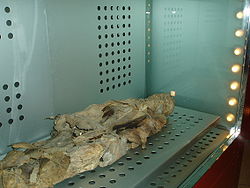
Mummy of San Andrés
Encyclopedia
The Mummy of San Andrés is a human mummy
belonging to the Guanche
culture (ancient inhabitants of the Canary Islands
, Spain
).
One of the best preserved Guanche mummies
, it is a male of about 25 to 30 years partially covered with goatskin with 6 strips that surround it. The mummy was found in a cave in a ravine outside the village of San Andrés. The area of the island of Tenerife
where the mummy was found, the Anaga massif, is rich in archaeological finds. It is thought that might be a Mencey (aboriginal king) or a leading figure in Guanche society of the time.
No one knows with certainty the exact year of its discovery, only that the mummy was exhibited at the Museo Municipal of Santa Cruz de Tenerife, until, in 1958, became part of the collections of the Museum of Nature and Man of Santa Cruz de Tenerife
, where it currently is. It is considered the best Guanche mummy preserved in the museum, and the most representative.

Mummy
A mummy is a body, human or animal, whose skin and organs have been preserved by either intentional or incidental exposure to chemicals, extreme coldness , very low humidity, or lack of air when bodies are submerged in bogs, so that the recovered body will not decay further if kept in cool and dry...
belonging to the Guanche
Guanches
Guanches is the name given to the aboriginal Berber inhabitants of the Canary Islands. It is believed that they migrated to the archipelago sometime between 1000 BCE and 100 BCE or perhaps earlier...
culture (ancient inhabitants of the Canary Islands
Canary Islands
The Canary Islands , also known as the Canaries , is a Spanish archipelago located just off the northwest coast of mainland Africa, 100 km west of the border between Morocco and the Western Sahara. The Canaries are a Spanish autonomous community and an outermost region of the European Union...
, Spain
Spain
Spain , officially the Kingdom of Spain languages]] under the European Charter for Regional or Minority Languages. In each of these, Spain's official name is as follows:;;;;;;), is a country and member state of the European Union located in southwestern Europe on the Iberian Peninsula...
).
One of the best preserved Guanche mummies
Guanche mummies
The Guanches, the ancient inhabitants of the Canary Islands mummified their dead.This practice was intended to preserve the body of the deceased through embalming techniques similar to those performed in other ancient civilizations. Its purpose, linked to their religious beliefs, was to protect...
, it is a male of about 25 to 30 years partially covered with goatskin with 6 strips that surround it. The mummy was found in a cave in a ravine outside the village of San Andrés. The area of the island of Tenerife
Tenerife
Tenerife is the largest and most populous island of the seven Canary Islands, it is also the most populated island of Spain, with a land area of 2,034.38 km² and 906,854 inhabitants, 43% of the total population of the Canary Islands. About five million tourists visit Tenerife each year, the...
where the mummy was found, the Anaga massif, is rich in archaeological finds. It is thought that might be a Mencey (aboriginal king) or a leading figure in Guanche society of the time.
No one knows with certainty the exact year of its discovery, only that the mummy was exhibited at the Museo Municipal of Santa Cruz de Tenerife, until, in 1958, became part of the collections of the Museum of Nature and Man of Santa Cruz de Tenerife
Santa Cruz de Tenerife
Santa Cruz de Tenerife is the capital , second-most populous city of the Autonomous Community of the Canary Islands and the 21st largest city in Spain, with a population of 222,417 in 2009...
, where it currently is. It is considered the best Guanche mummy preserved in the museum, and the most representative.
Data on the mummy

- Gender: male.
- Age: 25 to 30 years or so.
- Culture: Guanche.
- Type of mummification: mummy ceremonial.
- Type of burial: burial cave.
- Location: Anaga (Tenerife).
- Shown at: The Museum of Nature and Man (Santa Cruz de Tenerife), along with other Guanche mummies preserved.
- Interesting facts: Found on a wooden board (now this plate not displayed to the public).

